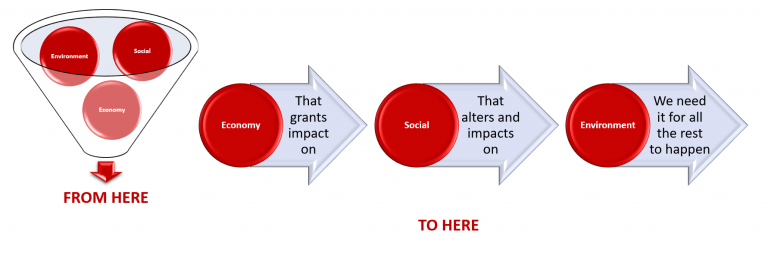The Triple Bottom Line: A Must for Sustainable Marketing
Feb 21, 2022
First, let’s answer an important question:
What exactly is the Triple Bottom Line?
In a nutshell, Triple Bottom Line is a way of looking at a company’s impact through three measures: economic value, environmental impact, and social responsibility, often referred to like people, profits, and the planet. It’s tied to the idea that a company can be profitable, while also improving the planet and making people’s lives better.
Why it matters
The world is changing, and it is changing for the better. We may not see it, many would not admit it, and some would say the opposite. But the truth is that we live longer, thereby exponentially increasing population pressure and the load on this planet’s natural resources, yet we have fewer wars, communicate better and more efficiently, and are constantly making knowledge more accessible to all. We are still far from the ideal situation, of course – way too many people starve every day, we still kill each other, and welfare is not efficiently distributed.
Companies started, not long ago, to admit they have a role in this situation. In 1981, Freer Spreckley published a paper called “Social Audit – A Management Tool for Co-operative Working” at Beechwood College in the UK, in which he suggested that companies should not only report on their economic results, but also on their impact on the environment and their capacity to generate what he called social wealth. In 1997, John Elkington coined the phrase “Triple Bottom Line” in his book Cannibals with Forks: The Triple Bottom Line of 21st Century Business. More recently, in 2018, Robert Sroufe published Integrated Management: How Sustainability Creates Value for Any Business, which included the notion of the integrated bottom line as a unique management model that blends all these concepts. The stage was set for many marketing authors (including me) to start approaching this issue within the marketing world and to use it as to framework for planning and measuring sustainable marketing. Even the father of modern marketing, Philip Kotler, included the issue of a company’s role beyond profit in the book Brand Activism: From Purpose to Action, which he co-authored with Christian Sarkar.
Profits are key to Triple Bottom Line sustainability
Common sense tells us that we live in our bundle of natural resources called planet Earth. Without it, none of us would exist (at least until we have our first permanent base in outer space). In order to create social impact or wealth, we need to take care of our planet. We could say then, that environmental responsibility is our first order of business since, without the environment, there are no people to impact. Although social needs vary widely depending on a socioeconomic level, demography, geography, and political situation, generating a positive social impact require resources – in almost all cases, this includes economic resources. To plant trees you need money; to deliver food, you need money; to build houses … you guessed it – money. It is fair to say that positive social impact cannot exist without economic resources (in most cases).
Economic resources have only one source of origin: companies. Even public funds come from taxes paid by companies and taxes paid by individuals from their paychecks, which are also generated by enterprises. So, why is it that some environmental organizations and social NGOs (non-governmental organizations) are still demonizing companies as merely profit seekers that are polluting the world and distributing misery among workers and society? Let’s get to the meat of the issue: Some companies are merely profit monsters and society (and social media) is taking care of them by shortening their lifespans or pushing them to the right side of issues. This doesn’t mean that monetarism or capitalism (as defined by Milton Friedman) are the best approaches to economics, since they do not, in theory, take social and environmental equity into account.
A fair and evolved combination of these three “currencies” – economic, social, and environmental – is the new and needed way to measure business success. Shortsighted companies that fail to see this and, accordingly, are also becoming short-lived.
Marketing turns ideas into action
If we indeed subscribe to the idea that companies have a role beyond profit, marketing must communicate it and help bring social and environmental impact planning and management from purpose into action. That is why we increasingly see stakeholder and sustainability programs included in the marketing and communications spheres of control, and why sustainable marketing is crucial to realizing Triple Bottom Line success.

The marketing discipline has a huge responsibility, first in changing mindsets and second in ensuring that companies actually make a positive difference operationally in the ways they say they will.
Changing mindsets: Marketing efforts must change the mindset of many NGOs and nonprofits, as well as much of society, that still think that making money while helping make a better world is bad. It’s not. If companies don’t make money while helping the environment and society, that help will not be sustainable in the long run and will become just a cosmetic approach to doing good while doing well.
Making good words operational: Marketing efforts must also go beyond the surface, ensuring that companies actually operate with an eye towards social and environmental good rather than just speaking about it – for example, ensuring green action rather than just greenwashing. This means that marketing efforts, too, must be economically sustainable, or they will not be able to deliver on positive social and environmental campaigns in the long run. To achieve ongoing marketing sustainability, marketers must know and prove their work’s economic impact on the bottom line of the business. Only if marketing projects are profitable will a company will be able to deliver campaigns that are also socially and environmentally responsible and impactful.
Economically sustainable marketing should be planned as an investment instead of as a cost, aiming for economic results instead of audience actions, and measuring one common, comparable performance indicator – return on investment (ROI).
Marketing can tie profit to people and the planet
In essence, we must change our mindsets and see it as a good thing that businesses make money responsibly and ethically. We should demand, through responsible consumer behavior – the most powerful tool to gain action from companies of all sizes – that companies transform their profits into social wealth and environmental equity.
On the marketing side, marketing departments must become strategic to the business by showing that this Triple-Bottom-Line approach is part of the very DNA of the business, embedded in its management model. Marketing departments must deliver on the approach themselves as well, by being accountable to the Triple Bottom Line and managing marketing activities for their robustly defined economic impact on the business.
Pablo Turletti, an internationally-recognized expert on marketing and sales efficiency and accountability, as well as a marketing keynote speaker, is the founder and CEO of ROI Marketing Institute (ROIMI), which has offices in Miami, Lucerne, and Madrid. ROI Marketing Institute helps companies around the world improve the efficiency of their marketing investments through precise measurement of the economic return on marketing activities. By directly connecting marketing projects and campaigns to a company’s bottom line, he helps turn them into true business investments. ROIMI provides a broad array of services, including auditing, competency-building, implementation support, consulting and research. Turletti is the author of the books ROI Marketing: The New Performance Standard and Marketing & Sales ROI: What Is It Good For? Learn more about the ROI Marketing Institute at roimarketinginstitute.com, and follow Pablo Turletti at twitter.com/pabloturletti or linkedin.com/in/pabloturletti/.

